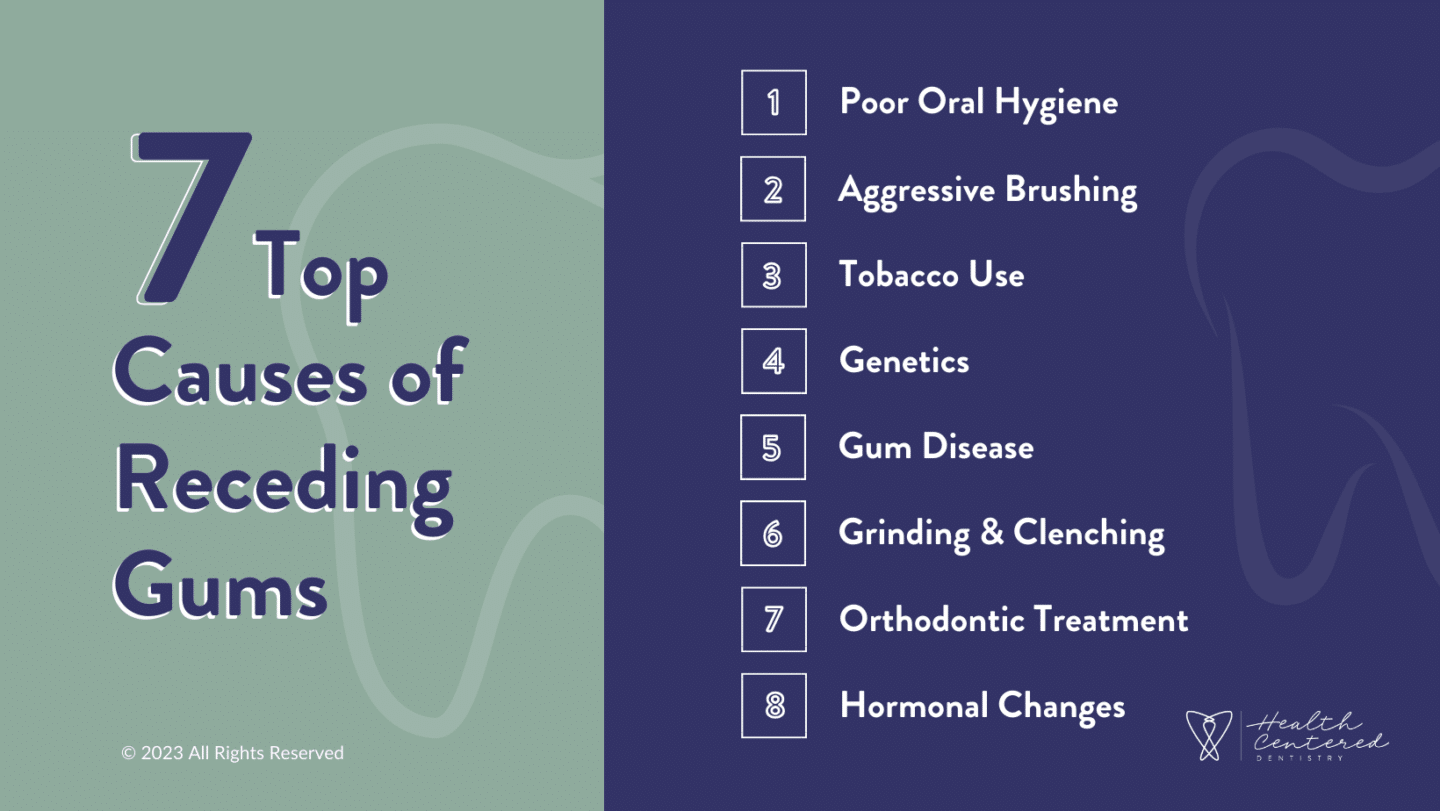A smile is often the first thing people notice about you, and your oral health plays a significant role in maintaining that beautiful grin. However, many individuals are unaware of the potential threats lurking beneath their smiles. One common dental issue that can negatively impact your oral health is receding gums.
Our gums help to support our teeth and ensure that we have an environment for healthy root development. And when this environment becomes compromised, a host of oral health problems can develop.
In this comprehensive guide, we will dive into the top causes of receding gums and what you can do to prevent them.
When was your last dental checkup? Reach out to Health Centered Dentistry in Anchorage today and schedule an appointment.
Understanding Receding Gums

Receding gums, also known as gingival recession, occur when the gum tissue surrounding your teeth pulls back or wears away. This exposes the tooth’s root and can lead to various dental problems, including increased sensitivity, swollen gums, tooth decay, and even tooth loss.
8 Top Causes of Receding Gums
1. Poor Oral Hygiene
Neglecting your oral hygiene is one of the most common problems that lead to gum recession. Inadequate brushing and flossing allow plaque and tartar to build up on your teeth, leading to gum disease, which can result in gum recession.
2. Aggressive Brushing
While good oral hygiene is essential, brushing your teeth too vigorously can have the opposite effect. Using a hard-bristle toothbrush and excessive force can wear away your gum tissue over time.
3. Tobacco Use
Smoking or using smokeless tobacco increases your risk of gum disease, which is a major contributor to gum recession. Tobacco also limits blood flow to the gums, hindering their ability to heal.
4. Genetics
Some people are genetically predisposed to have thinner or more fragile gum tissue, making them more susceptible to gum recession. If your family has a history of receding gums, you should be particularly vigilant about your oral hygiene.
5. Gum Disease
Periodontal disease, characterized by inflammation and infection of the gums, is a leading cause of receding gums. It can erode the gum tissue and damage the bone supporting your teeth.
6. Grinding and Clenching
Habits like teeth grinding (bruxism) and clenching can put excessive pressure on your teeth, leading to gum recession over time. A night guard or stress management techniques may help alleviate these issues.
7. Orthodontic Treatment
In some cases, orthodontic treatment can cause minor gum recession as teeth are moved into their correct positions. However, this is usually temporary and can be managed with proper care.
8. Hormonal Changes
Hormonal fluctuations during pregnancy, menopause, and other life stages can affect gum tissue, potentially leading to gum recession.
Preventing Gum Recession
Preventing gum recession starts with maintaining good oral hygiene practices:
- Brush and Floss Regularly: Brush your teeth gently with a soft-bristle toothbrush and use dental floss or interdental brushes to clean between teeth.
- Visit Your Dentist: Regular dental check-ups and professional cleanings are essential for early detection of gum issues.
- Avoid Tobacco Products: Quit or abstain from smoking or using tobacco to improve your gum health and overall well-being.
- Manage Stress: If you clench or grind your teeth due to stress, consider stress-reduction techniques or speak with your dentist about using a nightguard.
- Healthy Diet: Consume a diet rich in vitamins and minerals that support gum health, such as vitamin C and calcium.
- Orthodontic Care: If you’re undergoing orthodontic treatment, follow your orthodontist’s instructions diligently.
- Hormonal Awareness: Be aware of hormonal changes in your body and discuss any concerns with your dentist.
Gum Recession Treatment Procedures
While mild gum recession is considered a tell-tale sign of poor oral hygiene, there could also be much more at play. This is why affected gum tissue needs to be inspected at the gum line by a trained dentist in order for a treatment plan to be developed and implemented.
Common treatment procedures for mild to severe gum recession include:
1. Scaling and Root Planing (Deep Cleaning)
- Procedure: This non-surgical procedure involves a deep cleaning of the teeth and roots to remove plaque and tartar. The dentist or dental hygienist may use special instruments to smooth the tooth’s root surface, making it harder for bacteria to adhere.
- Indications: Scaling and root planing are typically recommended for early stages of gum disease, known as gingivitis. They can help prevent further gum recession and improve overall gum health.
2. Gum Graft Surgery (Gingival Grafting)
- Procedure: In this surgical procedure, a periodontist or oral surgeon takes tissue from another area of your mouth or uses a donor source to graft it onto the receding gumline. This graft covers the exposed tooth root.
- Indications: Gum graft surgery is often necessary when gum recession is severe and cannot be effectively treated with non-surgical methods. It helps protect the tooth root, reduce sensitivity, and improve the appearance of your smile.
3. Pinhole Surgical Technique (PST)
- Procedure: PST is a minimally invasive technique where the dentist creates a small hole in the gum tissue above the receded area. Special instruments are used to gently reposition the gum tissue to cover the exposed root.
- Indications: PST is suitable for certain cases of gum recession, particularly if you prefer a less invasive option. It typically involves less discomfort and a faster recovery compared to traditional grafting procedures.
4. Orthodontic Treatment
- Procedure: Orthodontic treatment, such as braces or aligners, can be used to correct tooth misalignment or overcrowding which contribute to gum recession. By moving the teeth into their correct positions, gum recession can be reduced or prevented.
- Indications: This treatment is suitable for individuals with gum recession caused by tooth misalignment. It may be used on its own or in combination with other procedures.
FAQs about Gum Recession
1. Can gum recession be reversed?
Gum recession cannot be completely reversed, but it can be treated and managed effectively through various procedures and improved oral hygiene practices.
2. Is gum graft surgery painful?
The procedure is typically performed under local anesthesia, so you should not feel significant pain during the surgery. Post-operative discomfort can usually be managed with over-the-counter pain medication.
3. How long does it take to recover from gum graft surgery?
Recovery time varies but typically ranges from a few days to a few weeks. It’s essential to follow post-operative care instructions provided by your dentist or surgeon.
4. Are there any risks associated with gum recession treatment?
Like any medical procedure, there are risks, but they are relatively low. These may include infection, bleeding, or discomfort during the recovery period. It’s essential to discuss any concerns with your healthcare provider.
5. Can I prevent gum recession?
While not all cases of gum recession can be prevented, maintaining good oral hygiene, avoiding tobacco products, and seeking early treatment for periodontal disease can significantly reduce your risk.
Ensure that you Have Healthy Gums at Health Centered Dentistry
Health Centered Dentistry is your go-to destination in Anchorage for top-notch periodontal therapy. We understand that your gum health matters and our dedicated dental team is committed to delivering exceptional services that cover a wide spectrum — ranging from comprehensive routine checkups and cleanings to effective treatments for gum disease.
What sets us apart is our holistic approach to dentistry, which considers your overall well-being. We are acutely aware that gum disease can have a significant impact on your general health, so we pay close attention to its warning signs.
At Health Centered Dentistry, your oral health takes precedence. We prioritize your care with professional dentistry, a health-conscious mindset, and tailored services that cater to your specific needs. Our team employs cutting-edge technology and equipment while staying updated with the latest research on gum disease to restore and safeguard your gum health effectively. Because your well-being is our primary concern, we’re here to provide you with the highest level of care.
Are you ready to put a stop to receding gums before they get worse? Contact Health Centered Dentistry for a professional evaluation.


